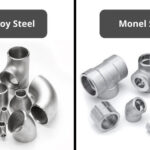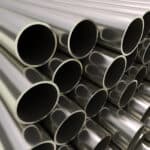Electric Resistance Welding (ERW) pipe is made by rolling metal and then welding it longitudinally throughout its length. ERW pipe has a welded junction in its cross-section throughout its length, whereas seamless pipe is created by extruding metal to the required length.
The seamless pipe, which is produced from solid round billets, has no welding or connectors. The seamless pipe is finished to dimensions and wall thickness standards in diameters ranging from 1/8 inch to 26 inch OD. High-pressure applications include hydrocarbon industries and refineries, oil and gas exploration and drilling, oil and gas transportation, and air and hydraulic cylinders, bearings, boilers, and automobiles, among others.
Pipes that are longitudinally welded, produced from a strip or coil, and have a diameter of up to 24 inches are known as ERW (Electric Resistance Welded). A ribbon of steel is pulled through a series of rollers and formed into a tube, which is then fused with an electric charge. It’s typically used in low- to medium-pressure applications like water and oil delivery. In India, Pearlites Steel is a leading producer and exporter of ERW Stainless Steel Pipes. Please contact us for further details on the product.
ERW Steel Pipe is available in a variety of sizes and lengths, ranging from 2 3/8-inch OD to 24-inch OD. Surface finishes are available in both bare and coated versions, with processing done on-site to meet customer needs.
Experts have already stated that ERW pipes are weaker than seamless pipes, hence its significance has always been contaminated. They are cold rolled after the hot rolling procedures, giving the ERW pipe superior corrosion and oxidation resistance. Both high- and low-pressure systems can benefit from these pipes. Tubing ends come in plain, threaded, and beveled varieties. These one-of-a-kind pipes can be easily customized to match your exact demands in a variety of shapes and sizes.
When investors employ ERW pipes, they are looking for a low-cost solution that is also incredibly dependable and can endure a long time without requiring extensive maintenance. These pipes are easy to manufacture and shape. The distinction between ERW and seamless pipes will continue to be debated by experts and those in the piping industry. Shop around for these pipes if you want to save money.
Every carbon steel pipe produced to API specifications, such as Casing pipe and Tubing pipe, uses seamless or electric weld providing processes. The distinctions between seamless and ERW pipes are considerable. Seamless Piping is distinguished by the fact that it is made by hot-working steel or, if necessary, cold-finishing the hot-worked product to get the desired shape, dimensions, and quality. The electric weld pipe’s welded seam is either heat-treated to a minimum temperature of 1,000°F or processed to eliminate any untampered martensite after welding.
Such ERW discrepancies are usually rectified if the electric-weld tube is heat-treated using the quenched-and-tempered process, which is necessary for API grades L80, C90, T95, and P110. The electric-welded pipe has one longitudinal seam created by electric-induction or electric-resistance welding without the need for filler metal. The weld seam edges are physically pressed together, and the welder generates the heat required for welding.
The manufacturing process is compared.
Both seamless and ERW processes are used to cast the raw material into ingots. To construct a pipe, the steel is stretched out into a seamless tube or pressed together and sealed with a weld. While it’s true that ERW pipe includes a seam that makes it potentially weaker, welding processes and quality assurance procedures have advanced to the point where the welded pipe will generally perform as expected when tolerances aren’t exceeded.
While the benefits of seamless piping are obvious, one critique is that the stretching and rolling process results in an inconsistent wall thickness when compared to the more precise thickness of steel sheets for welding.



